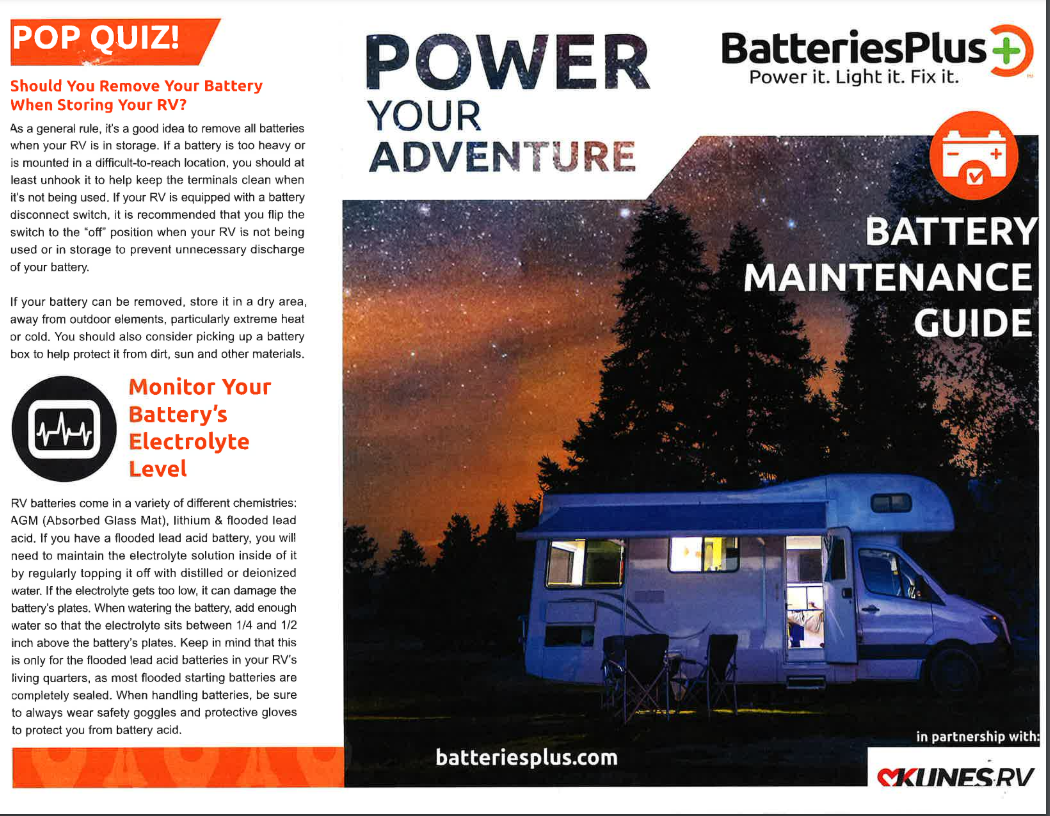Here at Kunes RV, we are proud to partner with Batteries Plus to provide you with top-quality battery products and expertise. Today, we are excited to share our knowledge and educate you on the best practices for maintaining your RV battery. With the right care and maintenance, you can ensure your batteries perform optimally, extending their lifespan and keeping your RV ready for your next adventure.
Removing When Storing
Experts at Batteries Plus recommend removing all batteries from your RV. If a battery is too heavy or inaccessible, at least unhook it to prevent unnecessary discharge and keep it clean. If your RV has a battery disconnect switch, turn it off when the RV is not in use to further prevent any unnecessary power loss.
If you can remove the battery, store it in a dry area away from outdoor elements, particularly extreme heat or cold, which can damage the battery. Using a battery box is highly recommended, as it provides extra protection from dirt, sun, and other materials that might cause damage. This simple step can help extend the life of your battery and ensure your RV is ready to go when you are.

Monitoring Your Battery's Electrolyte Level
RV batteries come in various types: AGM (Absorbed Glass Mat), lithium, and flooded lead-acid. If you have a flooded lead-acid battery, it's crucial to maintain the electrolyte solution by regularly topping it off with distilled or deionized water. Low electrolyte levels can damage the battery. When adding water, ensure the electrolyte level is between ¼ and ½ inches above the battery’s plates. This maintenance is only necessary for flooded lead-acid batteries in your RV’s living quarters; most flooded starting batteries are completely sealed. Always wear safety goggles and protective gloves when handling batteries to protect yourself from battery acid.
RV Battery Basics
RVs use different batteries to power various components. Depending on your RV, you may have between 1 and 9 batteries, which fall into three categories:
- Deep Cycle: Deep cycle batteries provide small amounts of energy continuously over a long period. They are used to power lights, fridges, TVs, and other applications in your RV’s living quarters.
- Starting: If you have a full motor home, you will need a starting battery. Similar to car and truck batteries, starting batteries provide the powerful burst of energy needed to turn over the engine. They are not suitable for powering additional sources, which is why deep cycle batteries are also necessary.
- Dual Purpose: Dual purpose batteries are a mix of both starting and deep cycle batteries, capable of performing the functions of both types.
Charging Your Batteries:
Keeping your battery charged is crucial for maintaining both your vehicle and living area batteries, whether after use or while in storage. To do this effectively, you will need a battery charger. When selecting a battery charger, consider the following three important factors:
- Battery Chemistry: Determine whether your battery is flooded, AGM (Absorbed Glass Mat), or lithium, and choose a charger compatible with that specific chemistry.
- Voltage: Check your battery’s voltage and ensure the charger is designed for that voltage. For example, if you have a 12-volt battery, make sure your charger works with 12-volt batteries.
- Amperage: Ensure the charger's amperage is appropriate for your battery. The charger's output should not exceed 30% of your battery’s rated capacity.
Pro Tip: Avoid Under and Overcharging
Both undercharging and overcharging can shorten your battery’s lifespan. Regular charging is essential to prevent the battery from getting too low, and monitoring the charging process is crucial to avoid overcharging.
Battery maintainers or standard chargers with a “maintenance” or “float” mode are excellent choices. These chargers automatically shut off to prevent overcharging and start charging again when your battery gets too low.

Types of Battery Chargers
There are many battery chargers on the market, but most fall into three basic categories. These charger types are compatible with both the vehicle and living area batteries of your RV:
- Standard Chargers: These chargers deliver a set voltage to recharge the battery.
- Trickle Chargers: These provide a very low charge that “trickles” into your battery over a long period to help prevent overcharging. However, if left unattended, they can still overcharge and damage the battery.
- Battery Maintainers: These automatic chargers actively monitor your battery. They switch off when the battery reaches a full charge and restart when the battery voltage drops below its optimal level. These are the best chargers for both deep cycle and starting batteries when leaving an RV in storage.




